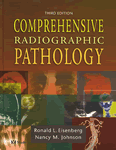|
|
|
| |
 |
|
|

|
 推薦指數:
推薦指數:





|
|
- 內容介紹
|
Comprehensive Radiographic Pathology, 3rd Edition
By Ronald L. Eisenberg, MD, FACR and Nancy M. Johnson, BA, RT(R)(CV)(CT)(QM)
Approx. 512 pages, Approx. 675 illus., Copyright 2003
Description
This well-illustrated textbook provides a foundation in the basic principles of pathology and familiarizes readers with the radiographic appearances of diseases and injuries that are most likely to be diagnosed with medical imaging. An introductory chapter on pathology introduces the pathologic terms used throughout the book. This chapter also describes the advantages and limitations of six widely-used modalities: ultrasound, computed tomography (CT), magnetic resonance imaging (MRI), nuclear medicine, single-photon emission computed tomography (SPECT), and positron emission tomography (PET). Each of the remaining chapters covers the pathology of a particular body system. A new summary of findings follows each major discussion of common pathologies and is presented in an easy-to-read table. Chapter outlines, goals, objectives, Radiographer Notes – helpful suggestions on how to produce optimal radiographs of a specific organ system – and end-of-chapter questions help readers understand concepts and assess their comprehension.
Key Features
High-quality radiographs and images from other modalities are reproduced on glossy paper, providing the best possible demonstration of the radiographic appearance of different diseases and injuries.
Comprehensive coverage helps readers develop a true understanding of disease processes and their radiographic appearance, including information essential for further required courses in radiographic pathology.
Pathology of various body systems is organized in separate chapters, each broken down into an initial discussion of general physiology followed by various pathologic conditions and their radiographic appearance and treatment.
If multiple imaging modalities can be used, the best initial procedure is indicated, as well as the sequence in which varying imaging studies should be performed.
Study and review tools such as objectives, goals, and end-of-chapter questions with answers at the back of the book help readers know what they should learn from each chapter and provide the opportunity to review concepts.
Radiographers Notes in every chapter provide helpful suggestions for producing optimal radiographs for each organ system, plus patient management techniques.
New to this Edition
250 new images demonstrate different modalities and some new pathologies that have been added to this edition, ensuring that this text remains an essential learning and reference tool for students and practitioners.
Discussions of new modalities in addition to the specialized imaging techniques covered in the previous edition – ultrasound, computed tomography, and magnetic resonance imaging – now include nuclear medicine, single-photon emission computed tomography (SPECT), and positron emission tomography (PET).
Treatment and prognosis sections offer brief explanations of treatment and prognosis for various pathologies.
An improved organization with chapter outlines and standardized heading schemes for systems chapters, including radiographic appearance and treatment sections for each pathology, allows easier navigation through the chapters.
Unique summary tables provide an easy-to-read summary of findings that follows each major discussion of common pathologies. Tables list the diseases just presented, their location in the body, radiographic appearance, and treatment.
|
|
|

